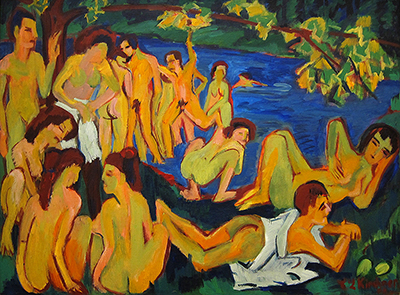 Buy Art Prints Now
Buy Art Prints Nowfrom Amazon
* As an Amazon Associate, and partner with Google Adsense and Ezoic, I earn from qualifying purchases.
This intriguing, busy multiple portrait was completed by Kirchner in the early 20th century and features the communal lives of modern Germans who was starting to be able to enjoy leisure time in society for the first time.
Bathers have been used on countless occasions throughout European art history and was particularly common during the Impressionist movement, with famous examples including multiple scenes by Pierre Auguste Renoir as well as Paul Cezanne, Jean-Leon Gerome and Edouard Manet. The combination of stunning models combined with the pleasure of spending leisure time together makes these an interesting and inspiring representation of society from previous centuries. In most cases the bathers are positioned in and around a local lake, with some foliage protecting them from prying eyes. Women would typically be used, but men can be found in some of Cezanne's portraits.
Kirchner's painting found here, bathers at moritzburg, was inspired by his own leisure time spent in the vicinity of Dresden over a number of summers. The artist chose to fill his scene with a large number of models, leaving little room to depict the surrounding environment. The overall atmosphere is relatively chaotic, but fun. Both genders are represented, meaning the innocence of other bather paintings is not found here, perhaps representing changing times in society compared to the impressionist pieces which arrived many years earlier. He spent the years of 1909 to 1911 visiting this spot, often with colleagues from the Brücke art movement.
The colour contrast between the heavy blue tones of the lake and the bright orange skin tones immediately grabs your eye, but we do know that it was originally even more noticeable before Kirchner later chose to make amendments to the painting in 1926. For him to return to a piece so many years later underlines his commitment to it at a time when he would have been particularly busy with a number of other projects as his reputation continued to rise.




